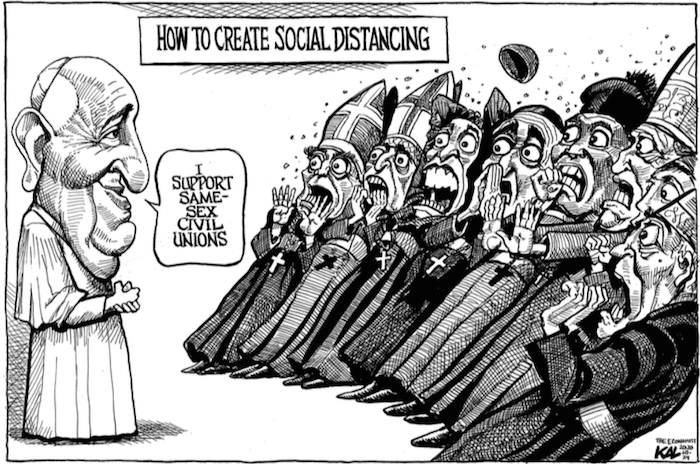— It is out of step with the continent’s values, many bishops say, and threatens to derail expansion in the church’s fastest growing region in the world.
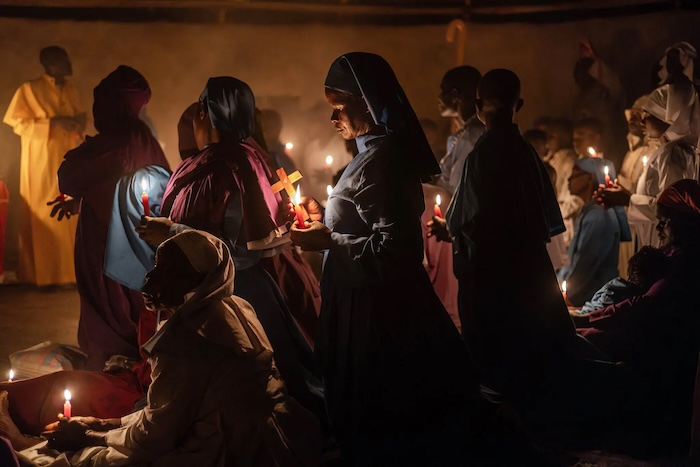
by
The Vatican’s recent declaration allowing the blessing of same-sex couples caused a stir around the globe, but perhaps most of all in Africa, a rising center of the Roman Catholic Church’s future. In one statement after the next, bishops in several countries spoke of the fear and confusion the declaration has caused among their flocks, and said it was out of step with the continent’s culture and values.
The bishops also harbored a deeper fear: that in a place where the church is growing faster than anywhere else in the world, and where many forms of Christianity are competing for worshipers, the declaration could slow the church’s expansion on the continent.
Bishop John Oballa of the Ngong Diocese near Nairobi said that a woman had written to him saying that a friend told her he wanted clarification on the declaration, or else he would convert to the Methodist Church.
“There’s a lot of vibrancy in many, many dioceses of Africa,” Bishop Oballa said in an interview. “We need to safeguard against anything that might derail that growth.”
He said he would advise his priests to give blessings to same-sex couples only if they were seeking God’s strength in helping “to stop living in same-sex unions.”
But if the couple merely wanted a blessing and planned to continue living the way they were, “it may give the impression of recognition,” he said, adding that he would advise clergy “not to bless because it may be scandalous to others — it may weaken the faith of others.”
This past week, the Vatican sought to placate those bishops alarmed by the new rule, saying that allowances should be made for “local culture,” but that it would remain church policy. Bishops opposed to the change, it said in a statement, should take an “extended period of pastoral reflection” to wrap their heads around why the Vatican says the blessing of same-sex couples is in keeping with church teaching.
Home to 236 million of the world’s 1.3 billion Catholics, Africa accounted for more than half of the 16.2 million people who joined the church worldwide in 2021. As bishops and other church leaders on the continent deal with the fallout among their parishioners over the declaration, broader concerns have been raised about whether it could lead to a rift between Pope Francis and a region that is a demographic bright spot for Catholicism.
“I think there is a rebellion already that’s started to say, ‘We’re not going implement this,’” said Father Russell Pollitt, the director of the Jesuit Institute South Africa, referring to the responses of bishops across the continent.

Some African clergy said they expected the Vatican and church leaders in Africa to work through their differences. But the declaration has complicated the relationship and will force difficult conversations between the church’s central authority and its African leaders. Some bishops have even hinted at a split between the values of African nations and the West, where some clergy had for years been running afoul of the Vatican’s guidance by blessing same-sex unions.
“In our African context, while recognizing the confusion existing in the more developed countries of new, unchristian models of ‘conjugal union’ and ‘styles of life,’ we are very clear on what a family and marriage is,” said a statement from the Kenya Conference of Catholic Bishops.
Without exception, church leaders in Africa have emphasized to their flocks that the declaration approved by Francis was explicit in saying that marriage remained a union between a man and a woman. They have stressed that the church’s doctrine on marriage has not changed, and that the declaration is about blessing the individuals, not their relationships.
Bishops in Malawi and Zambia have already said that, to avoid confusion, their clergy would be instructed not to give blessings to same-sex couples. The Catholic Bishops Conference of Nigeria did not take a firm position on the issue, and said in a statement that “asking for God’s blessing is not dependent on how good one is.” But it added that there was “no possibility in the church of blessing same-sex unions and activities,” a nod to the declaration’s nuance of blessing gay individuals not relationships.

The Southern African Catholic Bishops’ Conference affirmed that distinction in its statement. But it went further in saying that the church’s position was that “all people, regardless of their sexual orientation, must be treated with the dignity that they deserve as God’s children, made to feel welcome in the church, and not be discriminated against or harmed.”
The Vatican’s declaration has laid bare a tension for the church in Africa: How can it welcome homosexuals while not upsetting believers who stand firmly behind the church’s teaching that homosexuality is a sin?
Some African church leaders feel strongly that they should not even talk about homosexuality “because it is un-African,” said Bishop Sithembele Sipuka of the Mthatha Diocese in South Africa, who is also the president of the Southern African conference. Others, he added, felt differently because they personally knew gay people. “It is not our experience that it’s this thing they got from Europe,” he said.
His conference has interpreted the declaration to mean that people in same-sex relationships can be blessed, he said, but individually and not presented together.
Months before the Vatican’s declaration, Bishop Martin Mtumbuka of the Karonga Diocese in Malawi delivered a fiery sermon accusing Western pastors of trying to bend the word of God to accept homosexuals as a way of attracting a larger pool of priests and other religious vocations.
“Any one of us pastors who champions this is just being heretical and fooling himself,” Bishop Mtumbuka said, according to an audio recording of the sermon, which circulated widely on social media after the Vatican’s declaration.

Francisco Maoza, 48, a parishioner who lives in Malawi’s capital, Lilongwe, said he was relieved when his country’s bishops said they would not permit blessings for same-sex couples.
“I still think the position by the pope is wrong,” said Mr. Maoza, a carpenter. “In the African context, even in Malawian culture, we don’t allow men and women to marry people of their own sex. So why should priests be allowed to bless such unions?”
Another Catholic in Malawi, Josephine Chinawa, said she felt that Francis needed to step down because of the declaration.
“I really couldn’t understand his motivation,” she said. “Maybe he is too old.”
However, Father Pollitt said that some church leaders in Africa were being hypocritical. While they severely criticize homosexuality, he said, they say little about other “irregular unions” identified in the Vatican’s declaration, such as unmarried heterosexual couples who live together. The document says that priests can bless them, too. There have also been many cases on the continent of priests breaking celibacy rules by having children, but that does not get the same scrutiny among church leaders, he said.
“Let’s face facts: There is a lot of homophobia in Africa,” Father Pollitt said.
How the controversy over the blessing of same-sex couples plays out in the long run in Africa remains an open question. Some analysts say there may end up being very little tension, primarily because few gay couples are expected to actually ask for blessings.
“I don’t think they would even have the courage to introduce their partners to their parents, let alone coming to receive a blessing from the priest,” Bishop Oballa said.
Bishop Sipuka said that the Vatican and African church leaders would eventually find a way forward.
“I foresee a softening of position, maybe, by some who have reacted very strongly, as the document gets explained and discussed,” he said.

Complete Article ↪HERE↩!
Pope Francis allows blessings of same-sex couples, shifting Vatican guidance
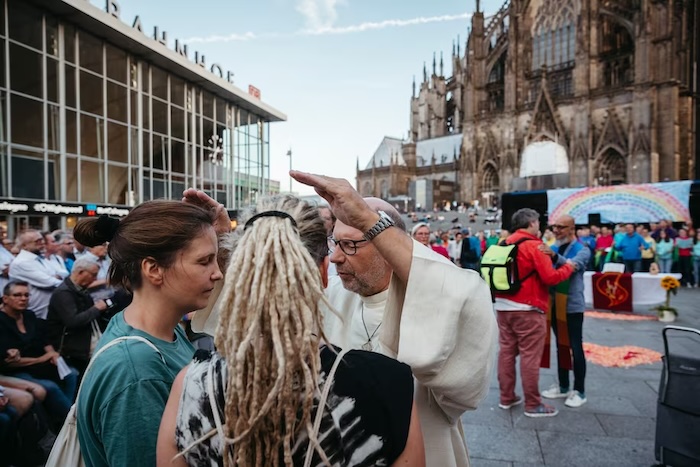
By Anthony Faiola and Stefano Pitrelli
The Vatican on Monday issued formal, definitive permission for Catholic priests to bless same-sex couples, as long as those benedictions are kept separate from marriage, a decree that amounts to an about-face after decades of discord between the LBGTQ+ community and the Catholic Church, which has long upheld that homosexuals are “disordered” and said any nod to their unions would be tantamount to blessing sin.
The guidance from the powerful Dicastery for the Doctrine of the Faith, issued after papal review and approval, largely reverses a 2021 ruling and expands on a far briefer statement of support for such blessings issued by Francis in September in response to questions raised by conservative clerics.
The document issued Monday says that blessings of same-sex couples should not suggest even the trappings of sacramental marriage — including traditional wedding vestments — or even ceremonies formally recognizing same-sex unions. But it offers guidelines for offering benedictions to people in same-sex relationships and explicitly gives permission to “ordained ministers” to conduct such blessings, while asking priests to use their own “prudent and fatherly discernment” to decide when doing so is appropriate.
Couples in “irregular situations” as well as “couples of the same sex” may receive priestly blessings, the Vatican said, so that these “human relationships may mature and grow in fidelity to the Gospel.”
“With its untiring wisdom and motherly care, the Church welcomes all who approach God with humble hearts, accompanying them with those spiritual aids that enable everyone to understand and realize God’s will fully in their existence,” the Vatican said.
The document departs from a 2021 Vatican statement that confirmed a ban on blessing same-sex unions, calling them not “even remotely analogous to God’s plan for marriage and family.” At the time, the ruling dashed the hopes of gay Catholics and seemed to indicate the limits of Francis’s reformist intentions.
>But since then, Francis had only mildly reprimanded priests in Western Europe who ventured to defy the ban. And he removed the conservative officials said to be the architects of the 2021 decision and appointed a fellow Argentine and ally, Cardinal Víctor Manuel Fernández, to the head the ministry in charge of Vatican doctrine. Fernández signed Monday’s decree.
“The Vatican’s new declaration is a huge a step forward for the church’s ministry for LGBTQ people,” said the Rev. James Martin, an American priest who ministers to the LGBTQ+ community and was handpicked as a delegate by Francis. “It provides guidelines, and it leaves a lot of it up to the minister. But this is a gift to LGBTQ Catholics and the document itself is a blessing.”
The global Catholic Church, with 1.3 billion adherents, is deeply divided on the issue of homosexuality. Liberal German, Belgian and Swiss priests have conducted same-sex blessings for years, prompting denouncements from conservative Catholic voices in the United States, while some Catholic bishops in Africa have refused to oppose legislation imposing the death penalty for homosexual acts.< The ruling on Monday, a declaration titled “Fiducia Supplicans,” again demonstrated how Francis has become less cautious and more willing to move against his conservative critics in the latter stage of his papacy. This year, he has decried the “strong reactionary attitude” among American conservative Catholics; removed one critic, Texas Bishop Joseph Strickland; and stripped another, U.S. Cardinal Raymond Burke, of his traditional privileges.
Francis began to open a door to the gay community shortly after becoming pope, declaring, “Who am I to judge?” when asked about gay priests. He has invited LGBTQ+ advocates to the Vatican, supported national laws for same-sex civil unions and called on church leaders to welcome gay Catholics.
The extent of that welcome became the most divisive issue during October’s month-long meeting in Vatican City on the direction of the faith. The wording of a concluding report failed to use inclusive language coined by the pope and declined to even repeat the term LGBTQ+. During that meeting, conservative bishops from Poland, Hungary, Nigeria, Ethiopia, Australia and elsewhere categorically rejected same-sex blessings, saying they would condone “sin” and amount to a “colonial” imposition from liberal Western Europeans.
Some conservatives noted Monday that while the document was being taken as broad acceptance of same-sex blessings, the new guidelines still don’t condone the most controversial practices in countries such as Germany, where some Catholic priests have overseen marriage-like ceremonies for same-sex couples. The document specifically notes that “this blessing should never be imparted in concurrence with the ceremonies of a civil union, and not even in connection with them. Nor can it be performed with any clothing, gestures, or words that are proper to a wedding.”
>But Martin and others interpreted the text as standing permission to hold such services inside Catholic churches, as long as they were framed in ways that avoided a reference to a Catholic sacrament or liturgical ritual.
Conservative Catholics expressed indignation. The right-wing Catholic outlet LifeSite News described the decision as “in contradiction to the unchangeable Catholic teaching that the Church cannot bless sinful relationships.” The Catholic church official teachings still describe homosexuality as “intrinsically disordered.”
“This document is scandalous and wrong, because of one underlying reason: You’re not blessing an individual who wants to change his life, as much as the couple that objectively lives in sin and has no intention of getting out of that,” said Roberto de Mattei, president of the conservative Catholic Lepanto Foundation. “I think this document will chiefly supply munitions to the most radical among Francis opposers … a minority convinced that Pope Francis’s words and gestures amount to heresy.”
In a significant way, however, the declaration simply expanded on the teachings of Francis already issued in September, when the Vatican made public the pope’s official response to conservative clerics, including Burke, who had demanded that he clarify the church’s position on same-sex blessings. In the response, dated Sept. 25, Francis wrote that there are “situations” that may not be “morally acceptable” but where a priest can assess, on a case-by-case basis, whether blessings may be given — as long as such blessings are kept separate from the sacrament of marriage.
“We cannot be judges who only deny, push back and exclude,” Francis wrote. “As such, pastoral prudence must adequately discern whether there are forms of blessing, requested by one or several people, that do not convey a wrong idea of a matrimony. Because when one seeks a blessing, one is requesting help from God.”
Innocenzo Pontillo, a gay Catholic activist in Florence who is in a same-sex union, called Monday’s decision long overdue — while acknowledging the double message the Vatican seemed to be sending by going to such great lengths to separate those blessings from the sacrament of marriage.
>“There were no doctrine-based justifications for not doing it, because, in the Catholic Church, they also bless tanks, cars, tractors, even salt,” he said. “A blessing only means a wishing for the best. It’s painful, though, that they should still feel compelled to reiterate: Remember, it’s not marriage! Look, we know it already.”
Complete Article ↪HERE↩!
The Pope and LGBT Catholics: Francis faces a conservative backlash
— As the pontiff apparently seeks to create more welcoming Catholic Church, a cadre of traditionalists have become emboldened in airing ferocious criticism
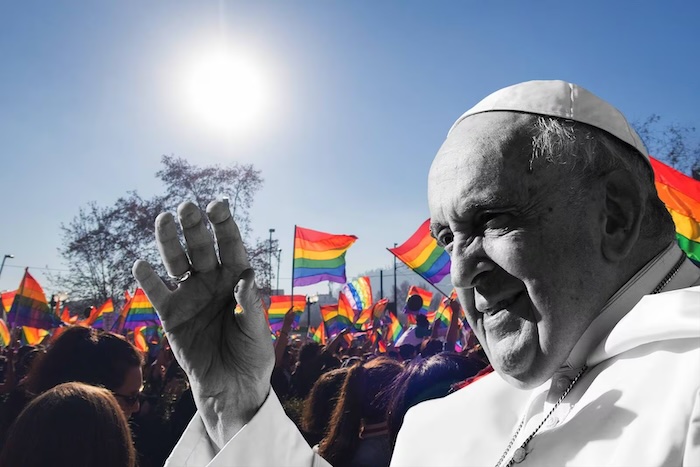
The photograph released on the Vatican’s official news channels was in many ways unremarkable, showing a smiling nun meeting Pope Francis in his official residence.
But close observers of the Catholic Church recognised something far from routine. This nun was Sr Jeannine Gramick, an advocate for LGBT Catholics who through the decades had been denounced by church authorities and once even feared excommunication.
Here she was, being welcomed by the man at the top. “The meeting was very emotional for me,” Sr Gramick said after the encounter last month. It was described by her LGBT advocacy organisation New Ways Ministry as “once unimaginable”.
It was the latest sign of an apparent opening of the church under Francis towards the LGBT community, which has drawn tentative optimism from some more liberal believers, but the outrage of a conservative flank.
It has deepened the suspicions of hardliners within the church that Francis is a dangerous reformer who risks worsening what they see as the confusion and undermining of church authority begun by the landmark 1960s Vatican II reforms.
Last weekend, Francis acted to impose his authority against a coterie of such traditionalists, who had become increasingly emboldened in airing public criticism.
Diabolically disordered clown
— Bishop Strickland criticising Pope Francis on Twitter
In a highly unusual move, the Vatican stripped Texas bishop Joseph Strickland of his position.
A vocal conservative and supporter of former US president Donald Trump, Strickland had been one of Francis’ fiercest critics in the United States, using a large media presence to criticise the pope’s efforts to give lay people responsibility and make the church more welcoming to LGBT people.
:quality(70)/cloudfront-eu-central-1.images.arcpublishing.com/irishtimes/BSTLLC6MWUR5C4MK7YX45VUX3Q.jpg)
“Vatican officials promote immorality,” Strickland wrote on Twitter last year. In another message, he approvingly shared a video in which Francis was criticised as a “diabolically disordered clown”.
A church investigation had found “that the continuation in office of Bishop Strickland was not feasible”, the Vatican statement said.
Can Catholic beliefs change with the times?
This was one of the questions posed by five conservative cardinals to Francis this year, in a list of queries they published in an apparent open challenge to the pope.
Asked whether divine revelation can be reinterpreted based on the changing norms of the day, Francis responded: “If it is understood as ‘interpret better’, the expression is valid.” He said some aspects of the Bible are of their time, such as slavery.
In another question, the cardinals asked whether it is permissible to bless same-sex unions, as some Catholic churches in Germany and Belgium have begun to do.
While only traditional marriages are recognised as such, “we must not lose the pastoral charity”, Francis told the cardinals. “Pastoral prudence must adequately discern whether there are forms of blessing . . . that do not convey a mistaken concept of marriage.”
By telling the cardinals that same-sex unions could blessed on a case-by-case basis, Francis opened the door on a past taboo.
:quality(70)/cloudfront-eu-central-1.images.arcpublishing.com/irishtimes/5GTDSUOCGPRXRFPQCWTFZVYZEA.jpg)
Since then, the pontiff has said that transgender people can be baptised, serve as witnesses and become godparents in some cases.
He has made clear that being gay is not in itself a “sin”, though remains of the view that homosexual acts are, along with all sexual activity outside traditional marriage.
But his papacy has striven to some extent to send the message that regardless, people should not be excluded from the church and denied pastoral care.
“If someone is gay and he searches for the Lord and has good will, who am I to judge?” he famously responded to a journalist shortly after his election in 2013.
Last month, former president of Ireland Mary McAleese, who is a doctor of Canon law, welcomed comments from Francis about blessings for same-sex couples but pointed out the pontiff’s stance is a “complete contradiction” of what he had said previously.
In December 2022, she accused him of “misogynistic drivel”, following an interview with a US-based Catholic magazine where he said women were not being deprived by being denied the right to become priests.
:quality(70)/cloudfront-eu-central-1.images.arcpublishing.com/irishtimes/LBMIFZRCACFL4NNMKN7IFFWVGM.JPG)
The life story of Sr Gramick starkly illustrates the shift in approach towards LGBT people since Francis became pope.
Sr Gramick began ministering to US LGBT communities in the 1970s and became an advocate for gay people within the church, holding workshops for Catholics that explained the spectrum of human sexuality.
This alarmed a number of bishops, and complaints triggered a Vatican investigation. The Vatican’s disciplinary arm, then led by the doctrinaire Cardinal Joseph Ratzinger – who would later become Pope Benedict XVI – publicly lambasted her for failing to accurately represent church teaching on “the intrinsic evil of homosexual acts”.
She was ordered to desist in her work in 1999. She did not.
Her organisation, New Ways Ministry, was censured for issuing a leaflet as marriage equality debates raged in 2010, outlining why Catholics might support legal unions for gay people. In response, US bishops declared the group could not describe itself as Catholic.
With the election of Pope Francis in 2013, however, change appeared to be in the air.
In a 2020 documentary, the pontiff said: “Homosexual people have a right to be in a family . . . What we have to create is a civil union law. That way they are legally covered.”
The comment landed in New Ways Ministry like a bombshell. “We were sanctioned by the US bishops for a position that the pope now held,” its executive director Francis DeBernardo recalled. “So I decided to write to Pope Francis.”
To his shock, a response arrived swiftly from the man himself on official Vatican letterhead, beginning a correspondence between Francis and Sr Gramick. In 2022, Francis wrote to the nun to congratulate her on 50 years of ministry, thanking her for the “compassion and tenderness” of her work, and saying her willingness to feel the pain of others and “condemn no one” was in the “style of God”.
This exchange culminated in the meeting in person last month.
“It still feels a little unreal,” said DeBernardo, who was in the meeting with Francis. “To realise that we have approval from the highest level of the church, when so many middle levels of the church had been against us for so long, it’s still sinking in.”
The issue of whether the church should open up further to LGBT people was among the topics discussed at an unprecedented gathering held in the Vatican last month.
The “synod on synodality” brought together hundreds of bishops, clerics, women in religious orders and Catholic lay people to deliberate on the future of the church, including issues such as the role of women and sexual abuse.
Participants wearing synod lanyards milled around side streets by the Vatican, excitedly greeting each other with the air of a grand reunion.
That expression – ‘We have always done it that way’ – is poison for the life of the church
— Pope Francis
In a large hall usually used for papal audiences, they sat in small groups at round tables to discuss a series of questions, in sessions interspersed by prayer. Participants took turns to speak before the issues were put to a vote.
One observer likened it to Ireland’s Citizens’ Assembly.
Its main emphasis was “listening to one another”, said Sr Patricia Murray, a senior Irish Loreto nun who was appointed to the commission that would draw up the synod’s conclusions. She described it as a way to “shift the feeling that the truth resides at the top of the hierarchy”.
Synods have been held since the 1960s, when they were introduced in Vatican II reforms as a way for bishops to advise the pope. But this was the first time it included non-clerics and women as voting members alongside bishops.
The idea of bringing the faithful into consultations was designed to overcome the polarising dynamics of social media that have amplified the divisions of the flock.
It was necessary to involve local churches “from the bottom up”, Francis said when he opened the synodal process, inviting congregations around the world to share their vision of the church.
“That expression – ‘We have always done it that way’ – is poison for the life of the church,” he said. “Those who think this way, perhaps without even realising it, make the mistake of not taking seriously the times in which we are living.”
Then came the backlash.
On the evening before synod participants were due to begin their deliberations in the Vatican, the de facto leader of a faction of fierce critics of Francis, US Cardinal Raymond Leo Burke, held a counter event in a theatre nearby.
He spoke against the “state of confusion and errors of vision that permeate” the synod process, and urged attendees to read a book to which he had written the foreword, called The Synodal Process Is a Pandora’s Box.
The work’s publisher, The American Society for the Defense of Tradition, Family, and Property (TFP), promotes the book as revealing the “heresy at work in the Synod” and an agenda to “distort doctrine, subvert tradition, and destroy the divinely instituted hierarchical nature of the church”.
Such groups encapsulate an extreme right-wing influence centred in the US, where a cadre of traditionalists, somewhat ironically, are vehemently opposed to the pope.
:quality(70)/cloudfront-eu-central-1.images.arcpublishing.com/irishtimes/2CVCJRKBIUBKX224F6BT2ORY74.jpg)
Discomfort at Francis’ criticisms of capitalism and insinuations about Latin American radicalism are at the heart of this opposition, alongside concerns about social issues.
Ample funding seems to be available: according to its tax records, the US branch of TFP reported annual revenue of $19 million (€17.5 million) last year, mostly from “contributions and grants”.
In the US, Francis faces a church that is divided along culture war lines and which has increasingly attracted conservative young men as recruits to the priesthood.
Whereas in the 1960s 68 per cent of new ordinands described themselves as theologically “progressive” and “very progressive”, that number has dwindled almost to zero today, according to a recent mass survey of thousands of US priests. It found half of newly ordained priests now describe themselves as “conservative” or “very conservative”.
Particularly among younger priests, celebrating the traditional Latin Mass gained popularity under Francis as a symbol of resistance to his reforms, church observers say.
It is seen as a token of allegiance to Pope Benedict, who had liberalised the use of the Latin Mass in a key reform and was nostalgically remembered as an upholder of tradition and doctrine.
Since Francis imposed restrictions on the use of the Latin Mass in 2021, the issue has become a flashpoint for conservative resistance to the pope.
“Francis will die, the Latin Mass will live forever,” one popular traditionalist blog in the US thundered after the pope restricted the rite.
At one point during the synod, participants wept as they heard the story of a young woman who died by suicide. She was bisexual and did not feel welcome in the church.
“I wept,” Dominican friar Timothy Radcliffe told a synod assembly in a live-streamed address. “I hope it changed us.”
Yet when the synod released its voting results and concluding report, those ambitious for change were disappointed.
The term “LGBT”, which appeared in an earlier draft, had disappeared, reportedly due to the discomfort of bishops from the Global South who see the word as a western imposition.
The conclusions deferred the question of whether women can be deacons to further study and consideration. They expressed “a profound sense of love, mercy and compassion” for those who feel hurt or neglected by the church, and acknowledged that issues like gender identity, sexual orientation, and troubled marriages “are controversial not only in society, but also in the church”.
Several theologians and Catholic commentators have since argued that the media focus on the synod’s most controversial topics has obscured the main progress that was made: the establishment of the synod model itself.
Senior participants have said it is now impossible to go back to the prior model of involving only bishops, and that the inclusion of women and laypeople is now here to stay.
Where conservatives fear the undermining of authority, proponents see the synod model as continuing the most ancient Catholic traditions, recalling the community involvement recounted in the New Testament of the earliest days of the church.
“Some people in the aula were adamantly opposed to a more welcoming approach to LGBTQ people, but that didn’t mean that they were any less my brothers and sisters in Christ,” Fr James Martin, a Jesuit who has advocated for the inclusion of gay people, wrote of his experience of the synod.
“The real message of the synod is the synod itself: how we came together to discuss difficult topics. And I was amazed that the topic was discussed so openly and so extensively in the synod, surely a major step forward in the church.”
Complete Article ↪HERE↩!
The Pope’s Coming Vatican Showdown with American Conservatives
— Francis’s recent journeys ahead of the October synod may be signals about the future direction of the Church.

By
Pope Francis’s “apostolic journey” to Mongolia earlier this month had the unexpected consequence of bringing Pierre Teilhard de Chardin, a singular and controversial French Jesuit scientist who died nearly seventy years ago, into the news cycle. As it turns out, Teilhard’s theology of cosmic spiritual progress is a useful way to understand the challenges that Francis is currently facing, as he and the Church prepare for a global synod next month in Rome. There, three hundred and sixty-three clerical and lay leaders representing two rival conceptions of the Church will encounter one another for several weeks of behind-closed-doors dialogue—a process that is meant to be amicable but may lead to open conflict prior to a second session next October.
The main question surrounding the Pope’s journey was “Why Mongolia?” The country, with a population of around 3.3 million, has only fifteen hundred Catholics, fewer than in a large parish in Chicago—and far fewer than in other Asian nations, such as Vietnam, which has seven million Catholics and a complex history with the Church, and may have benefited from a papal visit. (By comparison, in early August, Francis celebrated Mass in Lisbon for a million and a half congregants, many of them young people there for World Youth Day.)
But the trip suited Francis’s stated wish for the Church to go “to the margins,” and allowed him to spend time with Giorgio Marengo, an Italian cleric who has lived for more than two decades in Mongolia, doing missionary work, such as fostering Catholic-Buddhist dialogue. In August of last year, Francis made Marengo, who is forty-nine, the youngest member of the College of Cardinals, where he is likely to be a progressive presence for decades to come. And being in Mongolia gave Francis an opportunity to direct remarks, implicitly, to the neighboring powers: Russia, whose war in Ukraine has occasioned a shifting and at times confusing response from him; and China, where the Vatican’s agreement to let the government choose which priests become bishops, in exchange for tolerating the Church’s presence in that nation, has been widely criticized.
The trip also expressed Francis’s own long-distance interest in Asia. As a young man in Argentina, he wanted to be a missionary in Japan; then and afterward, he hoped to follow in the footsteps of influential Jesuits who spent large parts of their careers in Asia: St. Francis Xavier, Matteo Ricci, Pedro Arrupe, and Teilhard de Chardin. Born in France in 1881, Teilhard was a restless, searching figure: a priest, a poet, a stretcher-bearer in the First World War, a paleontologist based in China (where, in the nineteen-twenties, he took part in an important expedition in search of human origins), and a mystical theologian. His written work, a sustained effort to reconcile Christian theology with the theory of evolution, placed him in the vanguard of twentieth-century theology—though lately otherwise appreciative theologians have expressed concern that his emphasis on progress through evolution led him to contrast “the advancing wing of humanity” with “definitively unprogressive ethnical groups,” thus aligning himself with movements in support of race-based eugenics. Teilhard’s notion that the earth would someday be surrounded by a complex information system powered by human consciousness has been seen as anticipating the Internet, and the Episcopal homilist at Prince Harry’s wedding to Meghan Markle, in 2018, alluded to one of Teilhard’s aphorisms: “Someday, after mastering the winds, the waves, the tides, and gravity, we shall harness for God the energies of love, and then, for a second time in the history of the world, man will have discovered fire.” But Teilhard’s most memorable concept is the notion that “tout ce qui monte, converge,” or “everything that rises must converge”—that the various forces of natural evolution and human civilization are all ascending in a pattern of spiritual progress and will converge in a “Point Omega” at the end of time.
While doing field work in Mongolia, in 1923, Teilhard celebrated what he called a Mass on the World; lacking bread and wine to consecrate in the usual fashion, he simply consecrated the whole physical world, represented by the vast steppe where he stood. The Mass was expressive of Teilhard’s thought, which, in 1927 and afterward, drew the attention of the Vatican, where officials objected to his dismissal of the idea that the human race descended from Adam and Eve, and his corresponding lack of emphasis on the idea of original sin.
During the next three decades, Teilhard elaborated on his outlook in a number of essays and two books, “The Divine Milieu” and “The Phenomenon of Man.” The Vatican and his Jesuit superiors forbade him to publish any theological writing, but he remained a faithful Catholic and an obedient Jesuit. Following a visit to the U.S. in 1948, he settled in a Jesuit residence in New York City, where he died in 1955, on Easter Sunday—and the posthumous publication of his work began. During the Second Vatican Council, which first convened in 1962, criticism of his work eased, and his books became standard texts for progressive theologians—until they fell out of favor again, under the traditionalist Popes John Paul II and Benedict XVI, even as they personally spoke warmly of him from time to time.
This Pope, however, has looked emphatically to Teilhard as an example. In “Laudato Si,” his landmark encyclical on the climate, from 2015—he is expected to issue another one next month—he cited Teilhard as an inspiration. After celebrating Sunday Mass in Mongolia, Francis spoke ardently about Teilhard, on the centenary of the Mass that he celebrated there. “This priest, often misunderstood,” he said, “intuited that ‘the Eucharist is always in some way celebrated on the altar of the world.’ ” The Pope was bringing the priest back from the margins, and joining his own Asian journey to Teilhard’s.
Francis’s trademark style of discourse is to issue an offhand comment that is clearly on the side of progress, but to remain vague about how progress is to be achieved, and this tendency, too, has lately sparked controversy. Following a video call with young Russian Catholics, on August 25th, in which Francis urged them to connect with their roots in the “Great Russia of saints, rulers, Great Russia of Peter I, Catherine II, that empire—great, enlightened, of great culture and great humanity,” Archbishop Sviatoslav Shevchuk, the head of the Ukrainian Greek Catholic Church, immediately castigated the Pope for celebrating Russian imperialism past and present. Then the Jesuit journal La Civiltà Cattolica published a transcript of a conversation that Francis had with Portuguese Jesuits during his trip earlier that month. When one asked about the open criticism of him by some American Catholics, including bishops, Francis replied at length. “You have seen that in the United States the situation is not easy: there is a very strong reactionary attitude. It is organized and shapes the way people belong, even emotionally,” he said. “I would like to remind those people that indietrismo”—backwardness—“is useless, and we need to understand that there is an appropriate evolution in the understanding of matters of faith.” He later added, “Those American groups you talk about, so closed, are isolating themselves. Instead of living by doctrine, by the true doctrine that always develops and bears fruit, they live by ideologies.”
Which American groups, everyone wanted to know, was Francis talking about? In the Times, C. Preston Noell III, of the American Society for the Defense of Tradition, Family, and Property (a Pennsylvania-based offshoot of a Brazilian group founded in 1960 to resist supposed communist influence on the Church), pointed out that Francis has spent less than a week in the United States as Pope, suggesting that he is poorly informed about the life of the Church here. The Washington Post ran a dossier of suspects, among them Raymond Arroyo, a host on the traditionalist Catholic cable network EWTN, based in Alabama, who has personified the network’s opposition to Francis. Others pointed to Cardinal Raymond Burke, who served as the archbishop of St. Louis and then as a Vatican official, until he was removed from one post in 2014 and replaced in a different one earlier this year. In the foreword to a new book, Burke writes that the October synod will cause “confusion and error” and lead to “the grave harm of many souls.” The book has been published in eight languages by the Society for the Defense of Tradition, Family, and Property, which has sent copies to bishops and clergy, some of whom will be delegates to the synod.
Complete Article ↪HERE↩!
Catholics call for Vatican to embrace women in leadership, LGBTQ community, report says
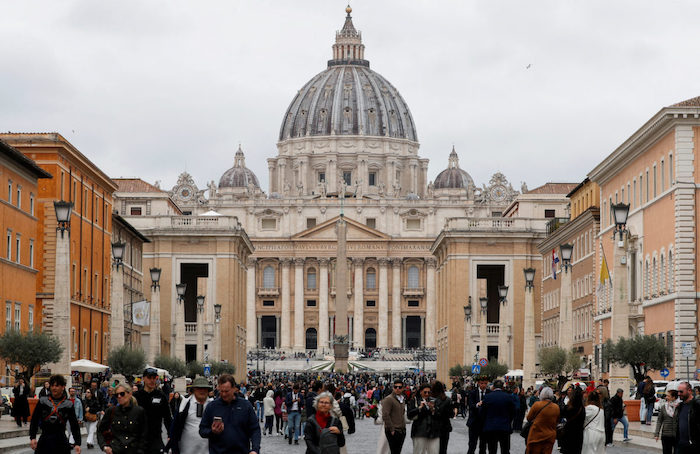
An unprecedented global canvassing of Catholics has called for the church to take concrete steps to promote women to decision-making roles, for a “radical inclusion” of the LGBTQ+ community and for new accountability measures to check how bishops exercise authority.
The Vatican on Tuesday released the synthesis of a two-year consultation process, publishing a working document that will form the basis of discussion for a big meeting of bishops and laypeople in October. The synod, as it is known, is a key priority of Pope Francis, reflecting his vision of a church that is more about the faithful rank-and-file than its priests.
Already Francis has made his mark on the synod, letting lay people and in particular women have a vote alongside bishops. That reform is a concrete step toward what he calls “synodality,” a new way of being a church that envisions more co-responsibility in governance and the key mission of spreading the Catholic faith.
The document highlights key concerns that emerged during the consultation process, which began at the local parish level and concluded with seven continent-wide assemblies. It flagged in particular the devastating impact that clergy sexual abuse crisis has had on the faithful, costing the hierarchy its credibility and sparking calls for structural changes to remove their near-absolute power.
The synthesis found a “unanimous” and “crucial” call for women to be allowed to access positions of responsibility and governance. Without raising the prospect of women’s ordination to the priesthood, it asked whether new ministries could be created, including the diaconate – a reflection of a years-long call by some women to be ordained deacons in the church.
The document noted that “most” of the continent-wide assemblies and “several” bishops’ conferences called for the diaconate question to be considered by the synod.
The document also asked what concrete steps the church can take to better welcome LGBTQ+ people and others who have felt marginalized and unrecognized by the church so that they don’t feel judged: the poor, migrants, the elderly and disabled, as well as those who by tribal or caste feel excluded.
Perhaps most significantly, the document used the terminology “LGBTQ+ persons” rather than the Vatican’s traditional “persons with homosexual tendencies,” suggesting a level of acceptance that Francis ushered in a decade ago with his famous “Who am I to judge” comment.
Even the seating arrangements for the synod are designed to be inclusive. Delegates are to be seated at round tables, with around a dozen laity and clergy mixed together in the Vatican’s big auditorium.
Previously, synods took place in the Vatican’s theater-like synod hall, where cardinals and bishops would take the front rows and priests, nuns and finally lay people getting seated in the back rows, far from the stage.
Unlike past working documents, the synthesis doesn’t stake out firm points, proposals or conclusions, but rather poses a series of questions for further discussion during the October assembly. The synod process continues in 2024 with the second phase, after which Francis is expected to issue a concluding document considering the proposals that have been put to him by the delegates.
The working document re-proposed a call for debate on whether married priests could be considered to relieve the clergy shortage in some parts of the world. Amazonian bishops had proposed allowing married priests to minister to their faithful who sometimes go months at a time without Mass, but Francis shot down the proposal after an Amazonian synod in 2019.
It called for more “meaningful and concrete steps” to offer justice to survivors of sexual abuse. It noted that the faithful have also been victims of other types of abuse: “spiritual, economic, power and conscience abuse” that have “eroded the credibility of the Church and compromised the effectiveness of its mission.”
It suggested that the church must reevaluate the way authority is exercised by the hierarchy, suggesting structural, canonical and institutional reforms to eradicate the “clericalism,” or privilege that is afforded to clergy.
It acknowledged the fear and opposition that the synodal process has sparked among some bishops who see it as undermining their authority and power, but said transparency and accountability were absolutely necessary and that bishops should even be evaluated as a way to rebuild trust.
“The synodal process asks them (bishops) to live a radical trust in the action of the spirit in the life of their communities, without fear that the participation of everyone need be a threat to their ministry of community leadership,” it says.
Even before the synod began, the document and the consultative process that preceded it were already having an effect.
Sister Nadia Coppa, who heads the umbrella group of women’s religious orders, said anyone who exercises governance in religious orders was being called to develop a new way of exercising authority.
“It will be important for us to propose a style of governance that develops structures and participatory procedures in which members can together discern a new vision for the church,” Coppa told a press conference.
Complete Article ↪HERE↩!
New documentary follows the Rev. James Martin ‘Building a Bridge’ to LGBTQ Catholics
‘I just hope that it helps LGBTQ Catholics see that there’s a place for them in their own church — it’s their church, too — and also for Catholic leaders to hear these voices,’ Martin said.
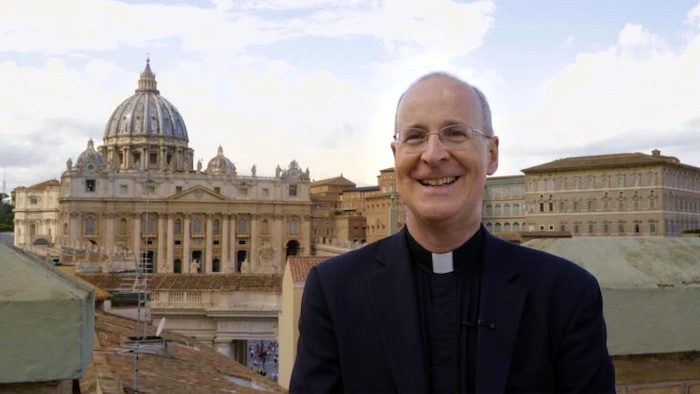
The Rev. James Martin never pictured himself managing a website aimed at helping resource LGBTQ Catholics.
He never saw himself starring in a documentary about the Roman Catholic Church’s relationship with its LGBTQ members.
He never set out to write or speak on issues related to LGBTQ people and the Catholic Church at all, he said.
And yet a film chronicling Martin’s ministry to LGBTQ Catholics — “Building a Bridge,” which was produced by Oscar-winning filmmaker Martin Scorsese and premiered last year at the Tribeca Film Festival — is streaming now on AMC+.
The documentary release comes as Martin launches an LGBTQ Catholic resource called Outreach, sponsored by America Media, where he is editor at large. Outreach includes a new website and a conference hosted in person for the first time this weekend at Fordham University in New York.
“I really feel like it’s been an invitation from the Holy Spirit to just continue to see where this goes,” Martin said.
The idea for the documentary about Martin’s ministry came to Brooklyn-based filmmaker Evan Mascagni not long after he moved to New York. Mascagni had grown up in a “really Catholic” community in Kentucky — so Catholic, he joked, he didn’t even realize there were other religions — but he had distanced himself from the church in college.
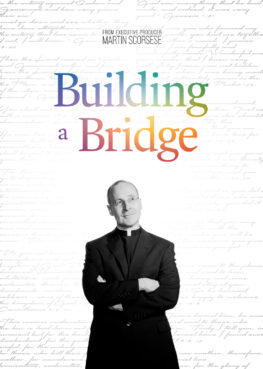
His mom kept sending him posts by “this cool priest she follows on Instagram,” who also was based in New York, he said.
When he finally attended a talk by the priest, who turned out to be Martin, Mascagni said he was “blown away.”
“I’d never felt energy like that in a Catholic church, honestly,” he said.
Mascagni also realized Martin’s story dovetailed with a story that co-director Shannon Post wanted to tell about a friend of hers who was among the 49 people killed when a gunman opened fire at the Pulse nightclub in Orlando, Florida.
Pulse was one of the city’s best-known gay clubs, and the 2016 shooting was the deadliest mass shooting in modern U.S. history at the time.
The response to the shooting — or, rather, the lack of response — by the Catholic Church was one of the reasons Martin said he first felt “emboldened” to write and speak publicly about the church’s relationship with LGBTQ people, he said.
“I was a little disappointed with the church’s official response to the massacre. What struck me at the time was that even in death, this community is largely invisible to the Catholic Church,” he said.
“And so that led to a Facebook video, which led to some talks, which led to this book ‘Building a Bridge,’ which led to this ministry, which just keeps going in new directions.”
The filmmakers began following Martin not long after his book “Building a Bridge: How the Catholic Church and the LGBT Community Can Enter Into a Relationship of Respect, Compassion, and Sensitivity” was published in 2017.
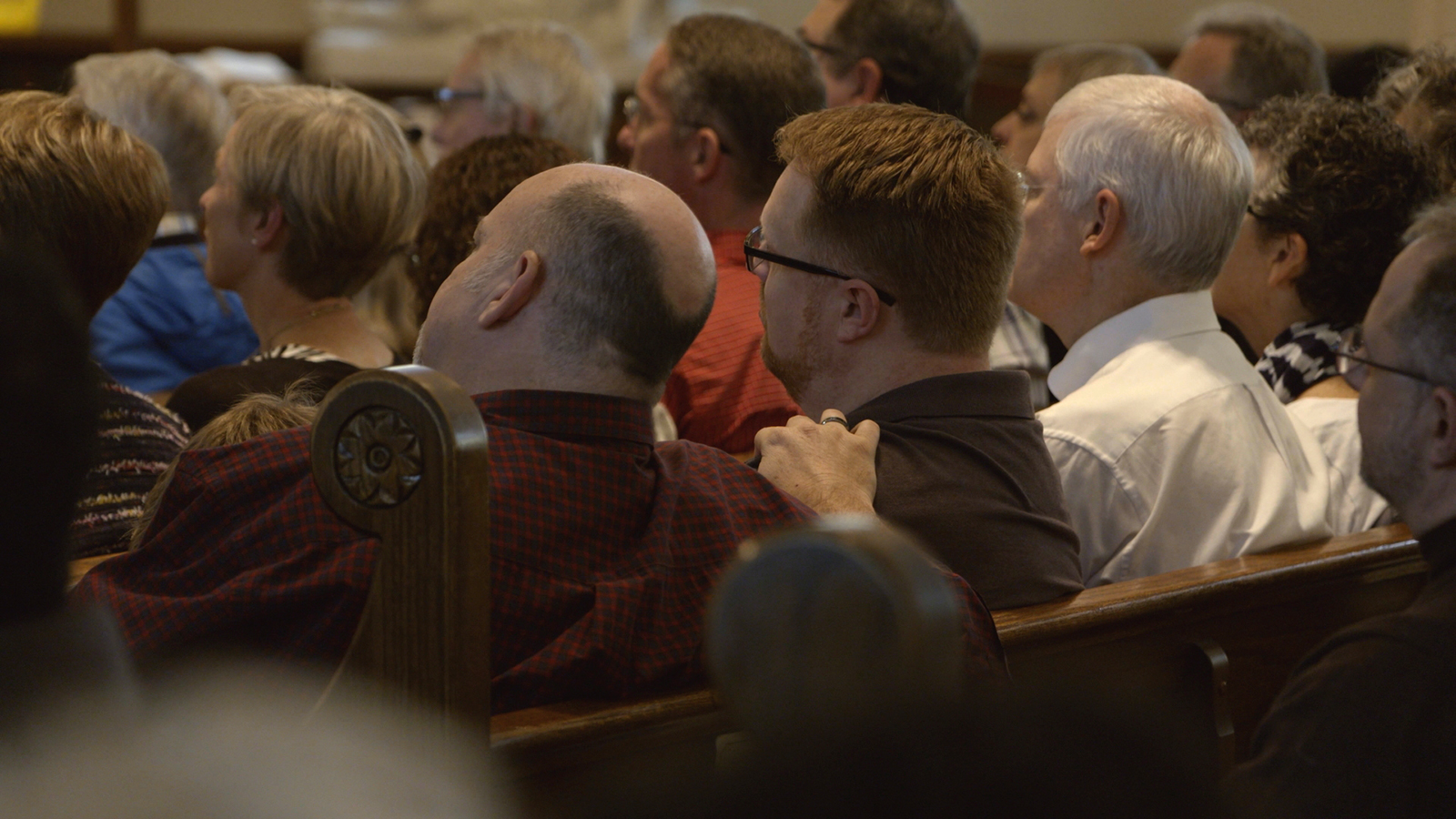
They filmed as some of the priest’s talks were canceled over fears of protest by conservative Catholic websites such as Church Militant, which also have organized social media campaigns against him. They kept rolling as he celebrated a Pre-Pride Mass at St. Francis of Assisi Church in New York and met at the Vatican with Pope Francis, who later wrote to Martin about the Outreach conference, previously held online.
“I pray for you to continue in this way, being close, compassionate and with great tenderness,” Francis wrote.
In that time, Martin said he’s become more confident — “primarily because I had that meeting with the pope.”
The priest’s message to the church has become “a little bolder,” he said.
“At the beginning, it was just like, ‘Treat these people with respect.’ Now it’s more, ‘Listen to them, accompany them, advocate for them,’ which is something I might not have said before.”
His message to the LGBTQ community has changed, too, as he’s been challenged by parish groups such as Out at St. Paul, featured in the “Building a Bridge” film. He’s realized the responsibility is on the church to reach out to the LGBTQ community, which has much less power, he said.
He sees the film as part of that work.
“I know that 1,000 times more people will see this movie than ever read my book or come to one of my talks. I understand the power of the media, and so, therefore, I wanted to support them as much as I could,” he said.
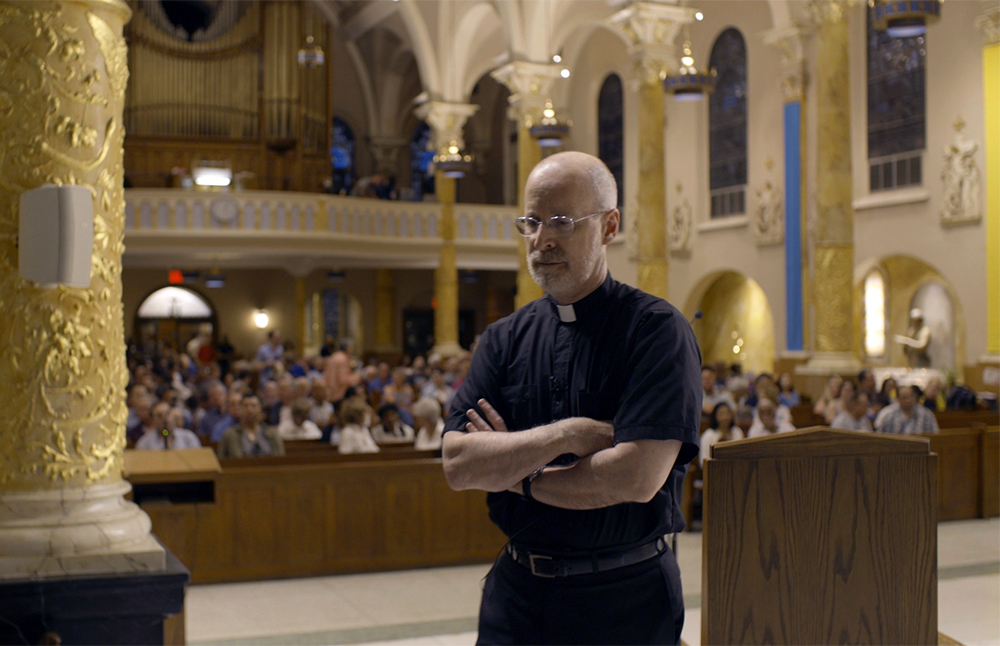
Martin said he realized Mascagni and Post were serious about making a documentary about his ministry when they showed up in Dublin, where he was invited to speak to the World Meeting of Families organized by the Vatican’s Dicastery for the Laity, Family and Life.
Being followed by cameras was “a threat to humility” as a priest, he said. But it came at the same time opponents were bombarding him with messages he was going to hell, so, he joked, “it balanced.”
It isn’t his first brush with fame. Martin has appeared on “The Colbert Report” and “The Late Show With Stephen Colbert” as the unofficial chaplain of Colbert Nation. He also has worked with Scorsese on two previous films, appearing as a priest in “The Irishman” and offering insight as a consultant for “Silence.”
Scorsese ended up becoming executive producer of “Building a Bridge” after hearing the documentary was in the works and reaching out to Mascagni and Post.
“If Martin Scorsese is asking you to see a rough cut, you’re gonna work as hard and as fast as you can to get it done,” Mascagni said, laughing.
Alongside Martin, “Building a Bridge” shares the stories of LGBTQ Catholics, their families and their parish ministries as they intersect with the priest and with the church.
It also features Michael Voris, founder of Church Militant. Mascagni said he wanted to show the impact Voris and his followers have had as they’ve opposed Martin’s ministry.
Voris told Religion News Service he thought the documentary was a “fair representation” of himself and Church Militant.
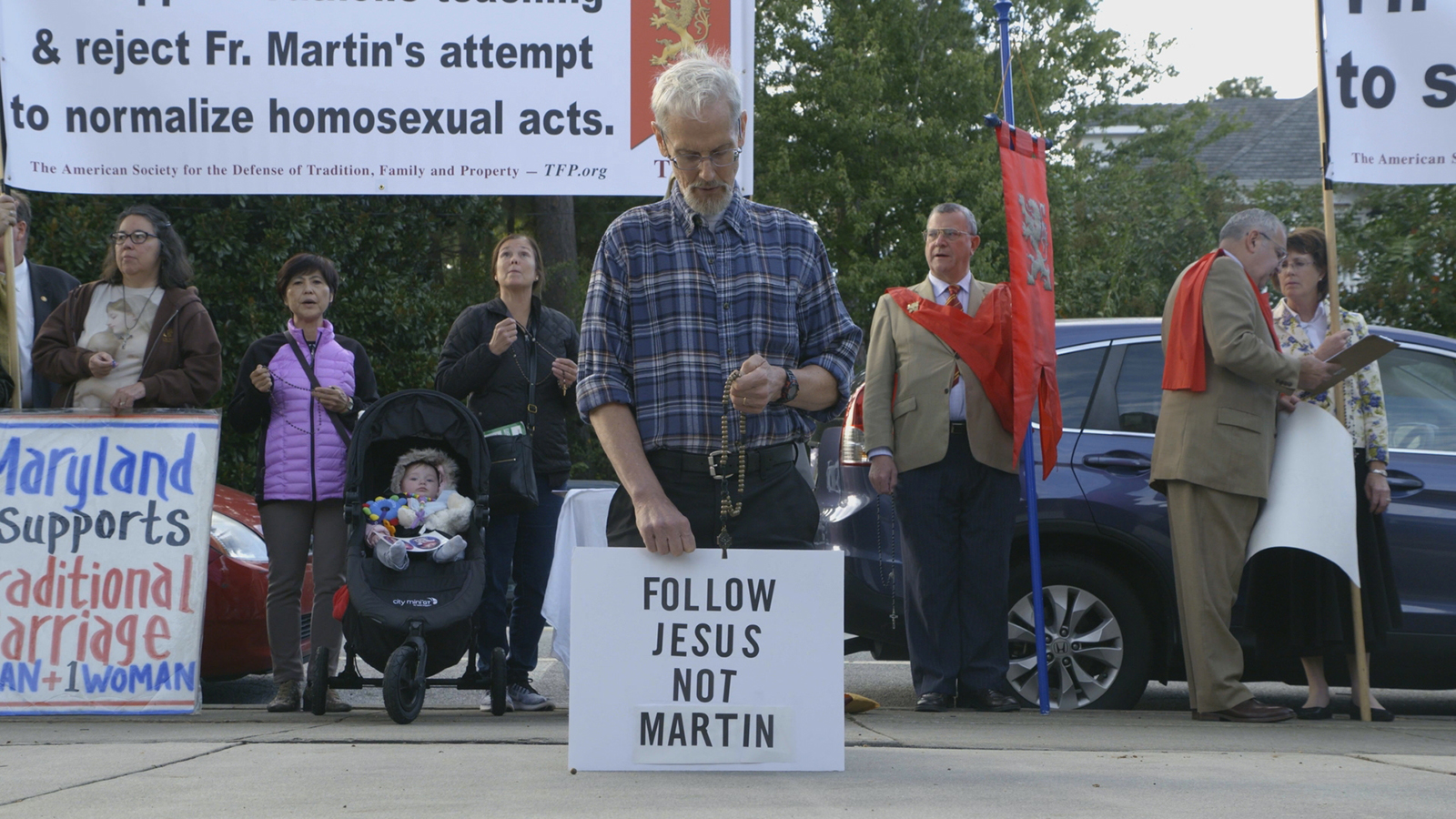
But, he said, “What sticks in my craw about it is that the church’s teaching doesn’t catch any real airtime.”
The Catechism of the Catholic Church refers to “homosexual tendencies” as “objectively disordered.” It also calls for LGBTQ people to be “accepted with respect, compassion, and sensitivity.”
The latter is the message Martin emphasizes, and the one the priest said he hopes audiences will take from “Building a Bridge.”
“I just hope that it helps LGBTQ Catholics see that there’s a place for them in their own church — it’s their church, too — and also for Catholic leaders to hear these voices,” Martin said.
“This is where Jesus not only wants us to be, but is. I mean, they are a part of the body of Christ.”
Complete Article ↪HERE↩!
Pope Sends More Mixed Messages on L.G.B.T.Q. Rights
An encouraging note from Pope Francis capped an especially disorienting week on the Vatican’s stance toward gay rights.
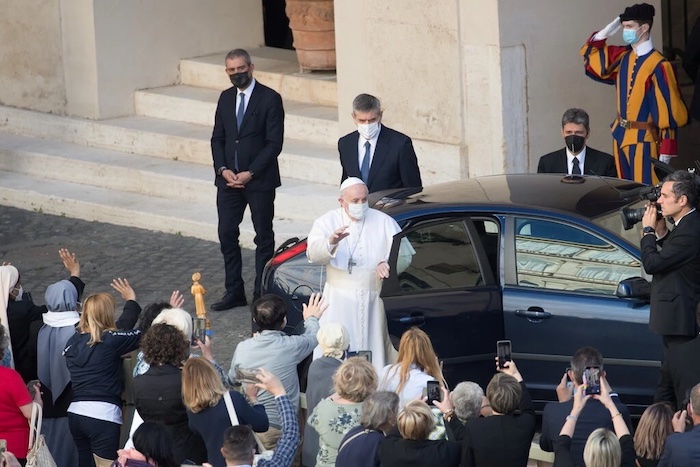
A leader in the Roman Catholic Church’s effort to reach out to L.G.B.T.Q. Catholics revealed on Sunday that Pope Francis had sent him a deeply encouraging note, capping an especially disorienting week on the Vatican’s attitude toward gay rights.
On Tuesday, the Vatican confirmed that it had tried to influence the affairs of the Italian state by expressing grave concerns about legislation currently in Parliament that increases protections for L.G.B.T.Q. people. And days later, the Vatican’s second in command insisted the church had nothing against gay rights, but was protecting itself from leaving the church’s core beliefs open to criminal charges of discrimination.
Nearly eight years after Pope Francis famously responded, “Who am I to judge?” on the issue of gay Catholics, it has become increasingly difficult to discern where he stands on the issue. A growing dissonance has developed between his inclusive language and the church’s actions.
The result is confusion and frustration among some of the pope’s liberal supporters who wonder whether the 84-year-old Argentine remains committed to a more tolerant church and is simply struggling to grasp the rapidly shifting contours of a difficult issue, or is really a social conservative trying to please everyone.
What is clear is that the new note will serve as fresh fodder in a battle within the church between frustrated progressives who hope the pope’s inclusive message will finally lead to change and wary conservatives, who are hoping the church will maintain its traditions. The Vatican’s own news service later reported that the pope had sent the letter.
In the handwritten letter dated June 21 and made public on Sunday, Francis praised and thanked the Rev. James Martin, a prominent Jesuit and the author of a book about reaching out to L.G.B.T.Q. Catholics.
“I see that you are continually seeking to imitate this style of God,” the pope wrote. “You are a priest for all men and women, just as God is a Father for all men and women. I pray for you to continue in this way, being close, compassionate and with great tenderness.”
Those words will almost certainly give succor to Francis’ liberal supporters, many of whom were deeply disheartened by a March response by the Congregation for the Doctrine of the Faith, the church’s top doctrinal office, to an inquiry about whether Catholic clergy have the authority to bless gay unions.
“Negative,” was the answer, which Francis approved.
Two people who support gay rights and are close to the pope say he told them that he relented under pressure from the congregation, a decision he regretted and hoped to rectify. The Vatican did not immediately respond to a request for comment on the accounts.
But Cardinal Gerhard Ludwig Müller, whom Francis fired from his position as the chief doctrinal watchdog in 2017, said that idea was absurd.
“The pope is the pope,” he said, adding that Francis was clearly in charge on such matters.
Cardinal Müller and other prelates say that Francis, on a personal level, simply does not like to hurt people’s feelings.
“He wants to be pastoral and he wants to be close to the people. It’s his specialty,” Cardinal Müller said. “It’s easier to be everybody’s darling than to say the truth,” he added. “He doesn’t like direct confrontation.”

Father Martin, who is often attacked by church conservatives, made the letter public after revealing it at a virtual conference for pastors and laypeople who administer to L.G.B.T.Q. Catholics.
In the letter, Francis said the Jesuit priest echoed Jesus in that his teaching was “open to each and everyone.” He concluded with a promise to pray for Father Martin’s “flock.”
But that flock has been led this way and that by the pope’s mixed signals over the years.
Francis stunned the faithful and a secular audience more accustomed to scolding about homosexuality and gay marriage when asked by reporters about a priest who was said to be gay, he responded, “Who am I to judge?”
His landmark 2016 document on family — titled “The Joy of Love” — rejected same-sex marriage but called on priests to be welcoming to people in nontraditional relationships, like gay people.
More recently, Francis expressed support for same-sex civil unions. His comments did not change church doctrine but amounted to a significant break from his predecessors.
Francis had made the remarks in a 2019 interview with the Mexican broadcaster Televisa, but the Vatican censored the report, and the footage emerged only in an October 2020 documentary.
For liberals, all of that seemed to be building momentum to real progress on L.G.B.T.Q. people in the church, which made the Vatican’s March rejection of the blessing of gay unions so much harsher.
Juan Carlos Cruz, a Chilean sexual abuse survivor and gay person whom the pope befriended, wrote an opinion article in a Chilean newspaper that criticized the doctrinal watchdog’s rejection of blessings as insulting to L.G.B.T.Q. Catholics.
The church’s doctrinal office is led by Cardinal Luis Ladaria, who was handpicked by the pope and is seen as in lock step with him.
In an explanatory note, the Congregation for the Doctrine of the Faith said that while welcoming gay people, who have a right to be blessed, the church will not bless same-sex unions because God “does not and cannot bless sin.” Blessing a same-sex union, it added, could give the impression of putting it on the same level as marriage.
“This would be erroneous and misleading,” the note said.
Vatican officials with knowledge of the document said that the pope did not at any time oppose the decision, and that he was absolutely clear on questions of church doctrine.
The decision prompted widespread disappointment, even disgust, among gay Catholics and their advocates.

Liberal Catholics were disappointed again this past week when the Vatican confirmed that the Holy See’s foreign minister, Archbishop Paul Richard Gallagher, had hand delivered a letter to the Italian ambassador to the Holy See expressing reservations about the bill that would add L.G.B.T. provisions to an existing law that makes discrimination, violence or incitement based on race or religion a crime punishable by up to four years in prison.
The church intervened early to change the bill because it feared the law might legally oblige it to conduct same-sex marriages or teach more liberal ideas about gender in Catholic schools, according to an official inside the church.
Alessandro Zan, the bill’s sponsor, said such concerns were outlandish and not reflected in the legislation.
But the pope clearly approved the intervention, Cardinal Giovanni Battista Re told Rome’s Il Messaggero newspaper on Thursday.
The reaction was intense and angry from Italians who accused the Vatican of impinging on the state’s democratic process and from frustrated and confused gay Catholics who again saw the pope, despite everything he had said, as acting against them.
In an apparent effort at damage control, Cardinal Pietro Parolin, the Vatican’s secretary of state and the second highest-ranking official after the pope, released a statement on Thursday.
He said that the Vatican was not seeking to block the legislation but worried that the vague draft language, and the enormous latitude of Italian judges, could lead to criminal discrimination charges for basic church practices. He insisted that hostility toward gay people did not motivate the Vatican opposition.
“We oppose any behavior or gesture of intolerance or hate toward people because of their sexual orientation,” he said.
Liberal supporters of Francis argue that letters like the one revealed by Father Martin on Sunday give them space to push ahead in their outreach. But Cardinal Müller said nothing of substance had changed since he left, and if anything, Francis had become stronger in his defense of the church’s core beliefs.
“The last signs were a little bit significant,” he said.
Complete Article ↪HERE↩!
Breaking a bad habit
— the Catholic Church and LGBTQ+ rights
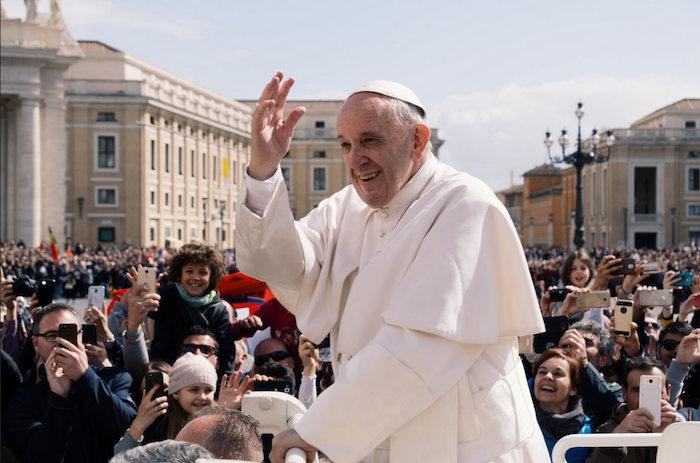
By Nick Alford
Director Evgeny Afineevsky’s latest film, ‘Francesco’, is about Pope Francis. It premiered at the Rome film festival in October 2020 and included an interview with the bishop of Rome himself. At some point during this interview, the pope said something extraordinary. Finally, after all these years, the Catholic Church would be accepting same-sex marriage. This was completely unexpected. People all over social media were shocked. Surely, this would mark the start of a new epoch in Catholicism.
For LGBTQ+ Catholics, this appeared to be a sign that their Pope truly supported them. For conservative Catholics, it was proof that the Pope is dangerously revolutionary, and that they risk losing followers to more right wing religious groups
So why were so many people convinced Pope Francis had changed his mind? It is possible people simply misunderstood what he was trying to say and thought same-sex marriages were synonymous with civil unions. Once the interview had been translated and copied enough times it was inevitable people would begin to make this mistake. Alternatively, even though the story wasn’t true, it provokes strong feelings. For LGBTQ+ Catholics, this appeared to be a sign that their pope truly supported them. For conservative Catholics, it was proof that the Pope is dangerously revolutionary, and that they risk losing followers to more right wing religious groups. It didn’t particularly matter that the pope hadn’t said anything new, because it still remains one of the most controversial political questions within Catholicism. But perhaps the most interesting idea is that since Francis took over in 2013, the idea of a pope supporting same-sex marriage is, whilst untrue, not quite as implausible as it once was.
Compared to his predecessors, Francis is progressive. The previous pontiff for example, Pope Benedict XVI, argued against even celibate gay men joining the priesthood. By contrast, Francis has claimed the Church should apologise to gay people for the discrimination they have faced, has argued against judging gay Catholics and has supported civil unions since his time as Archbishop of Buenos Aires. That seems remarkably liberal when compared to say, Bishop Tobin of Providence, Rhode Island, who has argued that same-sex unions are “objectively immoral”.
Considering how different Pope Francis is to not only those who came before him but to those around him presently, the idea that he one day might support same-sex marriage is understandable. A poll in the United States revealed that most Catholics view him favourably, and think that he has worked at least somewhat to change the Church’s position on homosexuality, and indeed the majority think he has changed the Church for the better. However, there is a growing share of US Catholics, particularly those who identify themselves as part of or leaning towards the Republican Party, who believe he is too liberal. But is this really the full story? One could paint Francis as a popular liberal figure who’s bringing in sweeping changes to the annoyance of more conservative Catholics, but the truth is far more complicated than that.
The official position of the Catholic Church remains that homosexuality is not sinful, but that homosexual acts are
The official position of the Catholic Church remains that homosexuality is not sinful, but that homosexual acts are. The Church argues these are “intrinsically disordered”. Francis has not changed this position. As Paul Elie put so succinctly in The New Yorker, “Francis, like his predecessors, made a distinction between gay people (good) and the way that they express passion and love (not good)”. Sexually active gay and bisexual people understandably might take offence at the idea that while they deserve respect and are owed an apology, part of their relationships are still being judged. Of course, sex and romance are not the same, but for many sex is an expression of romantic feeling. To be told this is wrong means the Catholic Church is maybe not as liberal as its LGBTQ+ members would like, nor as its more conservative members fear. Likewise, LGBTQ+ people might be doubly insulted as whilst their consensual relationships are constantly up for debate, the Church has a shameful history of covering up sexual abuse towards its members, including children.
Returning to marriage, in February 2015, Slovakia held a referendum that would, if passed, have banned same-sex marriage, though it was not recognised domestically anyway. It also would have prohibited adoption by same-sex couples. When visited by pilgrims from Slovakia, Francis commented “I wish to express my appreciation to the entire Slovak church, encouraging everyone to continue their efforts in defence of the family, the vital cell of society”. In 2014 he explicitly stated in an interview that marriage is “between a man and a woman”. Whilst the pope might be open to civil unions by states, he is clearly no supporter of marriage. He might have told a gay man in 2018 that “God made you like this”, but he remains unwilling to allow the same man to marry someone he loves. In fact, just before his native Argentina granted marriage rights in 2010 the then-Cardinal Jorge Mario Bergoglio claimed supporters of the new law were inspired by Satan.
Despite some inclusive language, Francis is still running a church that is not truly accepting of transgender and gender non-conforming people
On transgender issues, the pope seems to be taking a similar stance to his one on homosexuality. Although he has argued against abandoning trans Catholics, and perhaps surprisingly used the pronoun ‘he’ when describing a trans man, he has also argued against “gender theory, that does not recognize the order of creation” and compared it to “nuclear arms”. Like homosexuality, he argued that a person could have “tendencies” but argued spreading awareness in schools could be “ideological colonization” or “indoctrination”. The pope appears concerned that discussion of transgender issues could be used in a war on marriage. Despite some inclusive language, Francis is still running a church that is not truly accepting of transgender and gender non-conforming people. He might be more liberal than one might expect, but he is hardly a great ally either. This has frustrated many, such as Rev. Rodney McKenzie, Jr. of the National LGBTQ Task Force, who said such a position would “reject and dehumanize” rather than “welcome and affirm” trans people.
There is also the question of how much the Catholic Church is changing because of Francis, and how much it is changing to survive. Several Christian denominations already allow same-sex marriage, so the Catholic Church is hardly a trailblazer. Likewise, of the American Catholics mentioned earlier, 61% support same-sex marriage. It’s easy to say Francis is a liberal pope when compared to some of his bishops but compared to his followers in the USA he is more conservative. In Britain, a 2015 study by YouGov discovered that religious Catholics support gay marriage by 50% to 40%, unlike British religious Protestants who opposed it by 47% to 45%. A study in 2013 also discovered that more Catholics in Britain between the ages of 18 and 44 thought same-sex marriage was right than wrong. Additionally, in several countries across the world, fewer and fewer people are identifying as Catholic. In Argentina, despite remaining a majority of the population, the proportion of the population that identified as Catholic dropped by over 13% since 2008. Noticeable drops were also recorded in Italy, Switzerland, and the United States. Is Francis’ use of inclusive language an attempt to encourage younger, more tolerant Catholics to stay, whilst not changing Church positions in a way that would upset senior religious figures? That is not to say the pope is being insincere, as he has supported civil unions since before his time as pope. However, if figures around the world continue to drop, is it possible that Catholic Church positions could change its positions to seem more appealing to younger Christians? It seems only time may tell.
Pope Francis is an unusual figure. He has angered more conservative Catholics with some of his words, yet his positions on LGBTQ+ issues are not so dissimilar from that of his predecessors. He is more tolerant than many clerics, and yet less so than most British or American Catholics. He is also a man with tremendous power and influence. Take for instance the creation of anti-LGBT zones in Poland, a country that is overwhelming Roman Catholic and where lawmakers will openly say their values are shaped by the Church.
The Church’s positions have directly led to LGBTQ+ people feeling fearful. The pope’s views, and the Church’s positions, matter not just to Catholics but to people of other faiths and non-believers too. When the pope speaks, the world listens. Even the suggestion that Francis is supportive of same-sex marriage is enough to get people’s attention. As for what the future holds, that remains to be seen. A more LGBTQ+ friendly Catholic Church might happen one day, but for all he has said it is unlikely to happen under Pope Francis.
Complete Article ↪HERE↩!
In supporting same-sex civil unions, Pope Francis is showing how the Catholic definition of what constitutes a family is changing

Young people at the University of Santo Tomas in Manila, Philippines, cheer Pope Francis in 2015, following his comments endorsing same-sex civil unions.
Pope Francis referred to gay people as “children of God” in a recently released documentary, “Francesco.” He further noted that “a civil union law” needs to be created so gays are “legally covered.” The Vatican later confirmed the pope’s comments, but clarified that the church doctrine remained unchanged.
Public support for civil unions from Pope Francis is not entirely new. When he was archbishop of Buenos Aires, and again in a 2014 interview, he spoke about civil unions for same-sex couples.
While the Vatican is right in saying that church doctrine remains the same, as a theologian who has been writing about Catholicism and family for over two decades, I see in the pope’s comments evidence that Catholic understanding of who counts as family is evolving.
From judgment to mercy
Traditional Catholic doctrine holds that marriage between a man and a woman is the foundation of the family. Sex outside of marriage is judged to be immoral and, while gay people are not seen as inherently sinful, their sexual actions are. Same-sex marriages and civil unions, the Vatican says, are harmful to society and “in no way similar” to heterosexual marriages.
Yet in his comments made public on Oct. 21, the pope framed his support for civil unions in the context of family. “They’re children of God and have a right to a family. Nobody should be thrown out or be made miserable because of it,” he said in a news-breaking interview used in the documentary.
In researching for a book on Pope Francis, I found that he has consistently offered compassion for Catholics without traditional families. Soon after becoming pope in 2013, in response to a journalist’s question about a gay person, he famously said, “Who am I to judge?”
Mercy over judgment has been the mark of his papacy. The pope’s priority on extending mercy, theologian Cardinal Walter Kasper explains, especially pertains to families.
Surveys commissioned by the Vatican in 2015 found that Catholics desire more acceptance from the church for people who are single parents, divorced or have live-in relationships. Knowing that people often feel judged because their families aren’t perfect, Francis has tried to make them feel welcome. He has stressed that the doors of churches must be open to all.
When, in discussing same-sex civil unions, Francis said that gay people have “a right to a family,” he seems to have implied that civil unions create a family. Though he is not changing Catholic moral teaching, I argue that he is departing from traditional Catholic rhetoric on the family and offering an inclusive, merciful vision to guide church practice.
From family structure to family action
Changes in Catholic teaching in the 20th century paved the way for Francis’ recent moves.
In a 1930 Vatican document on marriage, Pope Pius XI defended the traditional family structure against perceived threats of cohabitation, divorce and “false teachers” who asserted the equality of men and women.
Three decades later, at Vatican II, a meeting of the world’s bishops from 1962 to 1965 that led to sweeping reforms in the Catholic Church, emphasis shifted to the role families could play in shaping society. Marriage was defined as an “intimate partnership of life and love,” and the family was praised as “a school of deeper humanity” where parents and children learn how to be better human beings.
Pope John Paul II, who was pope from 1978 to 2005, is often viewed as a foil to Pope Francis. In his writings, he defended heterosexual marriage and traditional gender roles, as well as rules against divorce, contraception and same-sex relationships. Yet the former pope contributed to shifting the Catholic conversation to ethical actions families can take.
In this regard, John Paul II’s most important document on the family Familiaris Consortio, 1981, gave families four tasks: growing in love, raising children, contributing to society and praying in their home. He taught that being a family means engaging in actions related to these tasks.
Catholic scholars like Mary Doyle Roche have since built on his framework to urge families to become “schools of solidarity” in which parents and children learn compassion for others.
Though same-sex couples remain excluded from official Catholic teaching, Catholic theologians such as Margaret A. Farley have suggested that these families, too, could prioritize love, social action and spirituality. Gay couples, she argued, “deserve the same protection under the law” as heterosexual couples. They also have the same moral obligations to each other and to the common good.
Pope Francis on inclusion
Pope Francis built on work done at Vatican II and the decades following it. One of his favorite ways of describing the church is as a “field hospital” that goes where people are hurting.
Though he has addressed many important social issues during his papacy, including economic inequality and climate change, he called the world’s bishops to special meetings in Rome only to discuss families. He urged them to find creative ways of ministering to people who feel excluded because they are not living in line with Catholic doctrine on marriage.
Themes of welcome and inclusion for single parents, divorced and remarried people and cohabiting unmarried couples were amplified in the document Francis wrote in 2016, “Amoris Laetitia,” or “The Joy of Love.”
For instance, theologian Mary Catherine O’Reilly-Gindhart sees Francis saying that cohabiting unmarried couples “need to be welcomed and guided patiently and discreetly.” This allows priests to meet couples where they are rather than shaming them or forcing them to hide their living situations.
What’s the future of the church?
Francis’ critics worry that the pope is watering down Catholic doctrine on marriage and family. But what I argue is that Francis is not changing doctrine. He is encouraging a broader view of who counts as families inside and outside the church.
In the same documentary in which Francis made his remarks on same-sex civil unions, he also criticized countries with overly restrictive immigration policies, saying, “It’s cruelty, and separating parents from kids goes against natural rights.” He was referring to the right to family, which “exists prior to the State or any other community.”
The comments in the documentary show a persistent move toward welcoming families in contemporary Catholic thought. Francis proposes that a welcoming church should support all families, especially those who are hurting. Similarly, as he says, governments should do the same – including supporting gay and lesbian couples.
Complete Article ↪HERE↩!
Social Distancing
Now look what you’ve gone and done, Francis!
